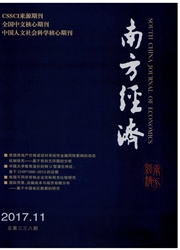

 中文摘要:
中文摘要:
构建小型开放新凯恩斯动态随机一般均衡框架,分析利率和汇率市场化改革的宏观经济效应。设置情形模拟,从波动性、脉冲响应和社会福利损失函数三个角度综合分析,研究发现:第一,均衡利率上升会引起主要宏观经济变量波动的增加;汇率弹性增大引起产出和汇率波动增大,但通胀和利率的波动减小;第二,脉冲响应分析显示利率和汇率市场化改革能够提高利率政策的调控效果;第三,汇率市场化改革造成的社会福利损失与利率市场化改革所处的阶段有关;若均衡利率升高过快,利率市场化改革引起的社会福利损失大于汇率市场化改革引起的社会福利损失。结论表明,利率和汇率市场化应逐步协调推进,要避免改革进程中均衡利率上升过快导致的经济波动增大。
 英文摘要:
英文摘要:
This article builds a small, open new Keynesian dynamic stochastic general equilibrium model, to analyze the macroeconomic effects of interest rate and exchange rate reform. By volatility modeling, impulse response analysis and social welfare loss function analysis, the study found that: First, the equilibrium interest rate rise will cause the macroeconomic variables fluctuate slightly increased; Exchange rate reform increase volatility of output and exchange rate, but reduce volatility of inflation and interest rate. Second, the impulse response analysis showed that interest rate and exchange rate reform can enhance the control performance of interest rate. Third, both interest rates and exchange rate reform increases loss of social welfare. If the equilibrium interest rate rise too fast, the interest rate reform of social welfare caused by the loss will be greater than the of exchange rate reform of social welfare. The conclusion shows that the interest rate and exchange rate should coordinate, reform should be avoided in the market equilibrium interest rate rise causes economic fluctuations increase too fast.
 同期刊论文项目
同期刊论文项目
 同项目期刊论文
同项目期刊论文
 期刊信息
期刊信息
